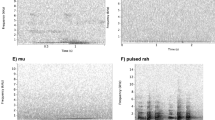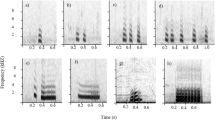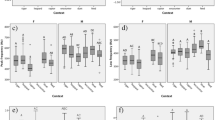Abstract
We propose a novel use of laser Doppler vibrometry (LDV) for elephant field bioacoustics and behavioral ecology, allowing investigators to determine who initiates and responds within a vocalization bout. LDV has been used in a variety of applications including engineering, biomedical research, and animal communication. We present LDV data collected from one captive African elephant in a group of three elephants within an open field during vocal exchanges. While rumble vocalizations were emitted within the group, we were able to identify the caller, as well as record the call structure parameters of that specific individual’s vocalization. The rumble vocalization had a duration of 5 s, with a fundamental frequency between 17 and 20 Hz and two harmonics at approximately 40 and 60 Hz. This LDV technique could be used to identify and record individual callers within a group where it is difficult to identify the caller, and where it is not feasible to use voice-activated collars. Specifically, LDV technology would make it possible to unobtrusively record an entire “let’s go” rumble sequence while being able to identify the ordering of callers within the sequence. LDV technology may also facilitate vocal communication studies in species where identifying the caller within a group is challenging. Finally, LDV technology could inform studies focused on the physics of signal propagation of coordinated signals within group-living animals.



Similar content being viewed by others
Data availability
This manuscript has associated data. [Authors’ comment: The data collected and analyzed for this study are available in the Utopia Scientific Lab GitHub repository, https://github.com/Utopia-Sci-Lab/Proof-of-Concept-LDV-Elephant-Vocalization-Bouts.]
References
J.H. Poole, K. Payne, W.R. Langbauer Jr., C.J. Moss, The social contexts of some very low frequency calls of African elephants. Behav. Ecol. Sociobiol. 22(6), 385–392 (1988). https://doi.org/10.1007/BF00294975
A.S. Stoeger, G. Heilmann, M. Zeppelzauer, A. Ganswindt, S. Hensman et al., Visualizing sound emission of elephant vocalizations: evidence for two rumble production types. PLoS One 7(11), e48907 (2012). https://doi.org/10.1371/journal.pone.0048907
A.S. Stoeger, A. Baotic, Information content and acoustic structure of male African elephant social rumbles. Sci. Rep. 6, 27585 (2016). https://doi.org/10.1038/srep27585
A. Baotic, A.S. Stoeger, Sexual dimorphism in African elephant social rumbles. PLoS One 12(5), e0177411 (2017). https://doi.org/10.1371/journal.pone.0177411
K.M. Leong, A. Ortolani, K.D. Burks, J.D. Mellen, A. Savage, Quantifying acoustic and temporal characteristics of vocalizations for a group of captive African elephants Loxodonta africana. Bioacoustics 13, 213–231 (2003). https://doi.org/10.1080/09524622.2003.9753499
S. Nair, R. Balakrishnan, C.S. Seelamantula, R. Sukumar, Vocalizations of wild Asian elephants (Elephas maximus): structural classification and social context. J. Acoust. Soc. Am. 126(5), 2768–2778 (2009). https://doi.org/10.1121/1.3224717
C.E. O’Connell-Rodwell, J.D. Wood, M. Wyman, S. Redfield, S. Puria, L.A. Hart, Antiphonal vocal bouts associated with departures in free-ranging African elephant family groups (Loxodonta africana). Bioacoustics 21(3), 215–224 (2012). https://doi.org/10.1080/09524622.2012.686166
J. Soltis, K. Leong, A. Savage, African elephant vocal communication I: antiphonal calling behavior among affiliated females. Anim. Behav. 70(3), 579–587 (2005). https://doi.org/10.1016/j.anbehav.2004.11.015
R.A. Charif, R.R. Ramey, W.R. Langbauer, K.B. Payne, R.B. Martin, L.M. Brown, Spatial relationships and matrilineal kinship in African savanna elephant (Loxodonta africana) clans. Behav. Ecol. Sociobiol. 57, 327–338 (2005). https://doi.org/10.1007/s00265-004-0867-5
W.R. Langbauer Jr., K.B. Payne, R.A. Charif, L. Rapaport, F. Osborn, African elephants respond to distant playbacks of low frequency conspecific calls. J. Exp. Biol. 157, 35–46 (1991). https://doi.org/10.1242/jeb.157.1.35
K.A. Leighty, J. Soltis, C.M. Wesolek, A. Savage, Rumble vocalizations mediate interpartner distance in African elephants, Loxodonta africana. Anim. Behav. 76, 1601–1608 (2008). https://doi.org/10.1016/j.anbehav.2008.06.022
K.B. Payne, W.R. Langbauer Jr., E.M. Thomas, Infrasonic calls of the Asian elephant (Elephas maximus). Behav. Ecol. Sociobiol. 18(4), 297–301 (1986). https://doi.org/10.1007/BF00300007
J.H. Poole, C.J. Moss, Elephant mate searching: Group dynamics and vocal and olfactory communication, in The Biology of Large African Mammals in their Environment, vol. 61, ed. by P.A. Jewell, G.M.O. Maloiy (Clarendon Press, Oxford, 1989), pp.111–125. (Proceedings of Sym. Zool. Soc. Lond.)
C.J. Moss, P.C. Lee, Female social dynamics: fidelity and flexibility, in The Amboseli Elephants. ed. by C.J. Moss, H. Croze, P.C. Lee (The University of Chicago Press, Chicago, 2011), pp.205–223
C.E. O’Connell-Rodwell, J.D. Wood, C. Kinzley, T.C. Rodwell, C. Alarcon, S.K. Wasser, R. Sapolsky, Male African elephants (Loxodonta africana) queue when the stakes are high. Ethol. Ecol. Evol. 23(4), 388–397 (2011). https://doi.org/10.1080/03949370.2011.598569
K. Leighty, J. Soltis, K. Leong, A. Savage, Antiphonal exchanges in African elephants (Loxodonta africana): collective response to a shared stimulus, social facilitation, or true communicative event? Behaviour 145(3), 297–312 (2008). https://doi.org/10.1163/156853908783402885
E.A. Archie, T.A. Morrison, C.A. Foley, C.J. Moss, S.C. Alberts, Dominance rank relationships among wild female African elephants, Loxodonta africana. Anim. Behav. 71, 117–127 (2006). https://doi.org/10.1016/j.anbehav.2005.03.023
G. Wittemyer, J.B.A. Okello, H.B. Rasmussen, P. Arctander, S. Nyakaana, I. Douglas-Hamilton, H.R. Siegismund, Where sociality and relatedness diverge: the genetic basis for hierarchical social organization in African elephants. Proc. R. Soc. B. 276, 3513–3521 (2009). https://doi.org/10.1098/rspb.2009.0941
H. Tabatabai, D.E. Oliver, J.W. Rohrbaugh, C. Papadopoulos, Novel applications of laser Doppler vibration measurements to medical imaging. Sens Imaging. 14, 13–28 (2013). https://doi.org/10.1007/s11220-013-0077-1
P. Lutzmann, B. Göhler, C.A. Hill, F. van Putten, Laser vibration sensing at Fraunhofer IOSB: review and applications. Opt. Eng. 56(3), 031215 (2016). https://doi.org/10.1117/1.OE.56.3.031215
J.J. Rosowski, R.P. Mehta, S.N. Merchant, Diagnostic utility of Laser-Doppler Vibrometry in conductive hearing loss with normal tympanic membrane. Otol. Neurotol. 24(2), 165–175 (2003). https://doi.org/10.1097/00129492-200303000-00008
C.E. O’Connell-Rodwell, X. Guan, S. Puria, Vibrational communication in elephants: a case for bone conduction, in Biotremology: Studying Vibrational Behavior, vol. 6, ed. by P. Hill, R. Lakes-Harlan, V. Mazzoni, P. Narins, M. Virant-Doberlet, A. Wessel (Springer, Cham, 2019), pp.259–276
G. Kastberger, F. Weihmann, T. Hoetzl, Social waves in giant honeybees (Apis dorsata) elicit nest vibrations. Naturwissenschaften 100, 595–609 (2013). https://doi.org/10.1007/s00114-013-1056-z
J.C. Nieh, J. Tautz, Behavior-locked signal analysis reveals weak 200–300 Hz comb vibrations during the honeybee waggle dance. J. Exp. Biol. 203(10), 1573–1579 (2000). https://doi.org/10.1242/jeb.203.10.1573
A.J. Fleming, A.A. Lindeman, A.L. Carroll, J.E. Yack, Acoustics of the mountain pine beetle (Dendroctonus ponderosae) (Curculionidae, Scolytinae): sonic, ultrasonic, and vibration characteristics. Can. J. Zool. 91, 235–244 (2013). https://doi.org/10.1139/cjz-2012-0239
J. Hummel, M. Kössl, M. Nowotny, Sound-induced tympanal membrane motion in bushcrickets and its relationship to sensory output. J. Exp. Biol. 214(21), 3596–3604 (2011). https://doi.org/10.1242/jeb.054445
T. Jonsson, B.D. Chivers, K.R. Brown, F.A. Sarria-S, M. Walker, F. Montealegre-Z, Chamber music: an unusual Helmholtz resonator for song amplification in a Neotropical bush-cricket (Orthoptera, Tettigoniidae). J. Exp. Biol. 220(16), 2900–2907 (2017). https://doi.org/10.1242/jeb.160234
E.L. Morley, T. Steinmann, J. Casas, D. Robert, Directional cues in Drosophelia melanogaster audition: structure of acoustic flow and inter-antennal velocity differences. J. Exp. Biol. 215(14), 2405–2413 (2012). https://doi.org/10.1242/jeb.068940
J. Sueur, J.F.C. Windmill, D. Robert, Tuning the drum: the mechanical basis for frequency discrimination in a Mediterranean cicada. J. Exp. Biol. 209(20), 4115–4128 (2006). https://doi.org/10.1242/jeb.02460
G.W. Uetz, J.A. Roberts, D.L. Clark, J.S. Gibson, S.D. Gordon, Multimodal signals increase active space of communication by wolf spiders in a complex litter environment. Behav. Ecol. Sociobiol. 67, 1471–1482 (2013). https://doi.org/10.1007/s00265-013-1557-y
D.O. Elias, A.C. Mason, W.P. Maddison, R.R. Hoy, Seismic signals in a courting male jumping spider (Araneae: Salticidae). J. Exp. Biol. 206(22), 4029–4039 (2003). https://doi.org/10.1242/jeb.00634
P.M. Narins, G. Ehret, J. Tautz, Accessory pathway for sound transfer in a neotropical frog. PNAS USA 85(5), 1508–1512 (1988). https://doi.org/10.1073/pnas.85.5.1508
V.S. Arch, T.U. Grafe, M. Gridi-Papp, P.M. Narins, Pure ultrasonic communication in an endemic Bornean frog. PLoS One 4(4), e5413 (2009). https://doi.org/10.1371/journal.pone.0005413
J. Casas, S. Bacher, J. Tautz, R. Meyhöfer, D. Pierre, Leaf vibrations and air movements in a leafminer-parasitoid system. Biol. Control. 11(2), 147–153 (1998). https://doi.org/10.1006/bcon.1997.0593
J. Casas, C. Magal, J. Sueur, Dispersive and non-dispersive waves through plants: implications for arthropod vibratory communication. Proc. R. Soc. Lond. [Biol]. 274(1613), 1087–1092 (2007). https://doi.org/10.1098/rspb.2006.0306
C.J. Clark, D.O. Elias, M.B. Girard, R.O. Prum, Structural resonance and mode of flutter of hummingbird tail feathers. J. Exp. Biol. 2016(18), 3404–3413 (2013). https://doi.org/10.1242/jeb.085993
K.S. Bostwick, D.O. Elias, A. Mason, F. Montealegre-Z, Resonating feathers produce courtship song. Proc. R. Soc. Lond. [Biol]. 277(1683), 835–841 (2010). https://doi.org/10.1098/rspb.2009.1576
J.D. Wood, B. McCowan, W.R. Langbauer Jr., J.J. Viljoen, L.A. Hart, Classification of African elephant Loxodonta africana rumbles using acoustic parameters and cluster analysis. Bioacoustics 15, 143–161 (2005). https://doi.org/10.1080/09524622.2005.9753544
R.C. Connor, R.A. Smolker, ‘Pop’ goes the dolphin: a vocalization male bottlenose dolphins produce during consortships. Behavior 133(9/10), 643–662 (1996). https://doi.org/10.1163/156853996X00404
R.P. Hobson, A.R. Martin, Behaviour and dive times of Arnoux’s beaked whales, Berardius arnuxii, at narrow leads in fast ice. Can. J. Zool. 7(4:2), 388–393 (1996). https://doi.org/10.1139/z96-045
Acknowledgements
We thank the PAWS staff for assisting in this study, along with The Elephant Sanctuary for an ongoing grant, and private donors to Utopia Scientific. We would also like to thank Polytec GmbH for loaning the LDV equipment for this research.
Author information
Authors and Affiliations
Contributions
The author CEO-R conceptualized the study and acquired funding. The authors CEO-R, KS, and ES contributed to the methodology of the study and data collection. The author KS conducted the data analysis, curation, and visualization, as well as providing and maintaining the equipment. The authors CEO-R, JLB, and KS wrote the first draft of the manuscript. ES coordinated elephants, setup scenarios to inspire them to be vocal, collaborated on experimental design and implementation, and oversaw staff to make sure experimental parameters were met. All the authors read and approved the final manuscript.
Corresponding author
Ethics declarations
Conflict of interest
The authors have no competing interests to declare that are relevant to the content of this article.
Additional information
Physics of Animal Navigation. Guest editor: Miguel A. F. Sanjuán.
Rights and permissions
Springer Nature or its licensor (e.g. a society or other partner) holds exclusive rights to this article under a publishing agreement with the author(s) or other rightsholder(s); author self-archiving of the accepted manuscript version of this article is solely governed by the terms of such publishing agreement and applicable law.
About this article
Cite this article
O’Connell-Rodwell, C.E., Berezin, J.L., Shambaugh, K. et al. Who is calling: proof of concept for the use of laser Doppler vibrometry in identifying individual callers within African elephant vocalization bouts. Eur. Phys. J. Spec. Top. 232, 253–259 (2023). https://doi.org/10.1140/epjs/s11734-022-00704-5
Received:
Accepted:
Published:
Issue Date:
DOI: https://doi.org/10.1140/epjs/s11734-022-00704-5




